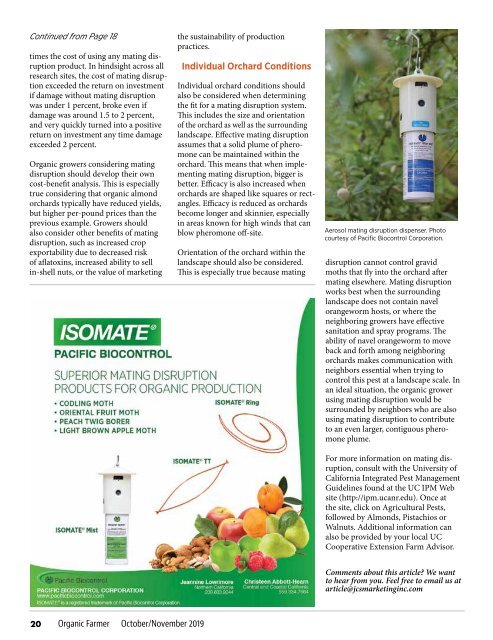Organic Farmer October/November 2019
You also want an ePaper? Increase the reach of your titles
YUMPU automatically turns print PDFs into web optimized ePapers that Google loves.
Continued from Page 18<br />
times the cost of using any mating disruption<br />
product. In hindsight across all<br />
research sites, the cost of mating disruption<br />
exceeded the return on investment<br />
if damage without mating disruption<br />
was under 1 percent, broke even if<br />
damage was around 1.5 to 2 percent,<br />
and very quickly turned into a positive<br />
return on investment any time damage<br />
exceeded 2 percent.<br />
<strong>Organic</strong> growers considering mating<br />
disruption should develop their own<br />
cost-benefit analysis. This is especially<br />
true considering that organic almond<br />
orchards typically have reduced yields,<br />
but higher per-pound prices than the<br />
previous example. Growers should<br />
also consider other benefits of mating<br />
disruption, such as increased crop<br />
exportability due to decreased risk<br />
of aflatoxins, increased ability to sell<br />
in-shell nuts, or the value of marketing<br />
the sustainability of production<br />
practices.<br />
Individual Orchard Conditions<br />
Individual orchard conditions should<br />
also be considered when determining<br />
the fit for a mating disruption system.<br />
This includes the size and orientation<br />
of the orchard as well as the surrounding<br />
landscape. Effective mating disruption<br />
assumes that a solid plume of pheromone<br />
can be maintained within the<br />
orchard. This means that when implementing<br />
mating disruption, bigger is<br />
better. Efficacy is also increased when<br />
orchards are shaped like squares or rectangles.<br />
Efficacy is reduced as orchards<br />
become longer and skinnier, especially<br />
in areas known for high winds that can<br />
blow pheromone off-site.<br />
Orientation of the orchard within the<br />
landscape should also be considered.<br />
This is especially true because mating<br />
Aerosol mating disruption dispenser. Photo<br />
courtesy of Pacific Biocontrol Corporation.<br />
disruption cannot control gravid<br />
moths that fly into the orchard after<br />
mating elsewhere. Mating disruption<br />
works best when the surrounding<br />
landscape does not contain navel<br />
orangeworm hosts, or where the<br />
neighboring growers have effective<br />
sanitation and spray programs. The<br />
ability of navel orangeworm to move<br />
back and forth among neighboring<br />
orchards makes communication with<br />
neighbors essential when trying to<br />
control this pest at a landscape scale. In<br />
an ideal situation, the organic grower<br />
using mating disruption would be<br />
surrounded by neighbors who are also<br />
using mating disruption to contribute<br />
to an even larger, contiguous pheromone<br />
plume.<br />
For more information on mating disruption,<br />
consult with the University of<br />
California Integrated Pest Management<br />
Guidelines found at the UC IPM Web<br />
site (http://ipm.ucanr.edu). Once at<br />
the site, click on Agricultural Pests,<br />
followed by Almonds, Pistachios or<br />
Walnuts. Additional information can<br />
also be provided by your local UC<br />
Cooperative Extension Farm Advisor.<br />
Comments about this article? We want<br />
to hear from you. Feel free to email us at<br />
article@jcsmarketinginc.com<br />
20<br />
<strong>Organic</strong> <strong>Farmer</strong> <strong>October</strong>/<strong>November</strong> <strong>2019</strong>


















